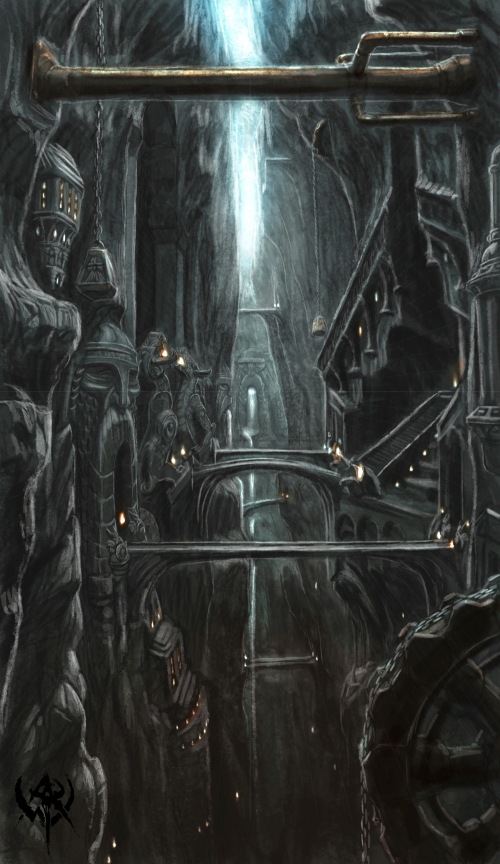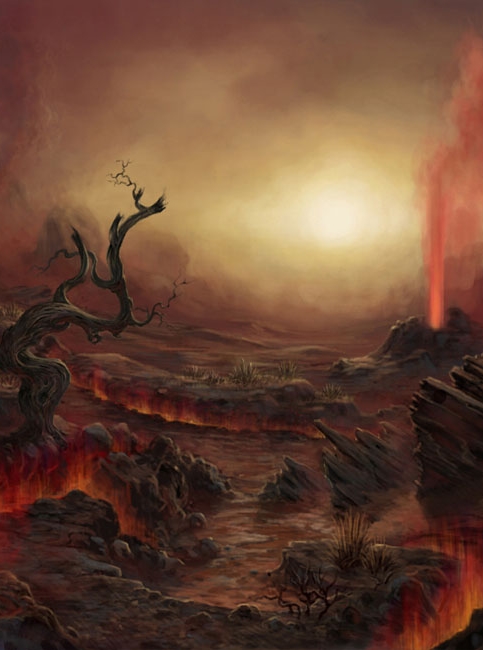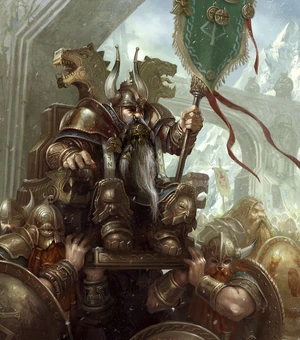 |
| Bucuresti, the old dwarven capital of Vechiul Regat |
Not long after the Rifts first appeared in the Arktos Wastes, migrating up from the grasslands of Kibula were the Dwarves. A short, squat, and taciturn people, they migrated northward in search for a permanent home - as well as to escape the swarms of Goblins and Orx that seemed to explode after Corruption's inception. Eventually, they stumbled upon what is now known as the Stara Mountains. They found it to be a good defensible position against their hated Mutant enemies, as well as a land of mineral resources, so they began their settlement.
What started as small villages in caves eventually turned into mining cities and towns among the stoney heights of the Staras. However, they were still beset on all sides by their enemies, and it seemed every village they built soon fell. This was until they allied with the massive civilization of the Elves, who had journeyed east during their exploration of the World.
The two found allies in each other - the Elves helped provide military aid and their powerful magics, while Dwarves provided their craftsmanship and natural resources. As time went on, however, the Elves became more demanding and gave little back to the Dwarves. Eventually the Dwarves united under a charismatic craftsman named Basarab, who revolted against the Elves and caused the century long War of Broken Hammers between them. When the dust settled, the Elves (fractured by their own civil war) retreated, leaving the Dwarves of the Stara Mountains independent, but depleted. With exhausted fanfare, Basarab declared himself the first Voivoide of Vechiul Regat - the Dwarven kingdom.
 |
| Lands affected by the Great Eruption |
Worried for his people, Voivoide Basarab began to make sweeping changes to his new empire in order to keep their strength without the help of the Elves over the 200 years of his reign. Unfortunately, most of these ideas were misguided, and the era is commonly referred to by Dwarven scholars as the Age of Strife.
One of the first things Basarab did was enslave a race of beings local to the Stara Mountains, who called themselves Gnomes. These Gnomes had awesome mechanical prowess, and were forced to create machinery that even today has not found an equal. Dwarves didn't abuse the Gnomes as much as they could, but they still lived in squalor for no pay and little prospects. Basarab then declared that every Dwarven Hold - whether they be small or large - be ruled by a noble called a Boyar. While a seemingly innocuous idea, Basarab installed his children in all the positions, leading to rivalries and jealousy.
This all came to a head when a long-extinct volcano near Bucuresti exploded - the resulting Great Eruption left Basarab dead, a cloud of darkness and ash permanently covering the desert of Iram, a gullet opening to the Great Warren of the Skrzzak and an in-roads for Orx to better assault Vechiul Regat. The Boyars began civil infighting on who would next be Voivoide, and it seemed as if the Dwarves were nearing extinction.
 |
| The Siege of Hateg, a major turning point in the Mutant Wars |
While Mihai was crowned by Karolus as the new Voivoide, he was wise enough to know the Dwarven kingdom could never fully recover from the Great Eruption and the Mutant Wars - many Holds had fallen, countless Dwarves had already migrated into safer mountains west and north, and Bucuresti needed massive repairs. As a final act, Mihai the Brave freed the Gnomes from slavery before declaring that he was Voivoide in only name - the glory of Vechiul Regat now long gone.
 |
| A Dwarven Boyar headed to war |
Though Bucuresti still thrives within the Stara Mountains despite the ages, few full Dwarven Holds are found in Stara anymore. Some have migrated west to the Alpennes, others have settled in the Gilded Imperium, and others have travelled north to Noreg. The largest Holds are massive underground cities - story-tall vaulted ceilings, massive causeways and buildings of stone, and architecture that dates back thousands of years. The smallest Holds are little more than mining camps, with only a dozen families within them.
Each Hold is ruled by a Boyar, while the nobility under them are called Kynatz. All Boyars still pay tribute and are technically under the authority of the Voivoide - currently known as Grigore - even though Vechiul Regat has no actual borders any longer. The Holds usually contain one large extended Clan, which the Boyar is usually the patriarch or matriarch. Many Holds also contain populations of Gnomes - even after their release, they didn't have really any place to go. As a result, they still suffer in their industrial jobs and slog in slums, but now they get marginal pay instead of none.
There are also three other important positions in a Dwarf Hold besides a Boyar - that of the Rune Master, Grudge Keeper and Master Engineer. The Rune Master oversees the forging of the mystical runes in many Dwarven constructs; the Grudge Keeper is a historian who records every sleight against a Clan in their enormous tomes; and the Master Engineer monitors the steamwork and industry of the Clan. These three are found in nearly every Hold and are close advisers to the Boyar.
 |
| The Vechiul Regat Armata strides headlong to war |
Their nobility are often stuck in their ways, dreaming of past glories rather than improving the Dwarves as a whole. True their might is great, their runes strong and their technology imposing, but Dwarf culture has been stagnating for centuries. The Holds are starting to fall apart, and their age is near over. Now they are embroiled in the Great War, an ally to their long-time companions in the Gilded Imperium, but it is unknown how long they can serve as a bulwark.
When any one Dwarven Hold marches to war, especially the imperial army of the Vechiul Regat Armata, it is an impressive sight. Slayers with blood-red mohawks stand side-by-side with meteoric iron wearing flamethrower wielders. Tunnel fighters, rune thanes, and the powerful gyrocopters and cannons of Gnomish make leave the Dwarves with one of the most powerful armies when they can gather up their numbers.
OUTRO
Yowch, quite a lengthy one for the Dwarves (and Gnomes). Obviously I took a lot of hints from WFRP 1e Dwarves, but I inserted a hearty amount of Romanian history in there - especially focused on Wallachia. I'm also starting to build up timelines here - the War of Broken Hammers, the Elven Civil War, the Age of Strife, the Great Eruption, the Mutant Wars, etc. I'm also shying away from magic and religion unless it is very important - both of those will get their own posts going in depth. I'll probably head into another Europan country next - I'm leaning towards Ruthen or Hespia.

No comments:
Post a Comment